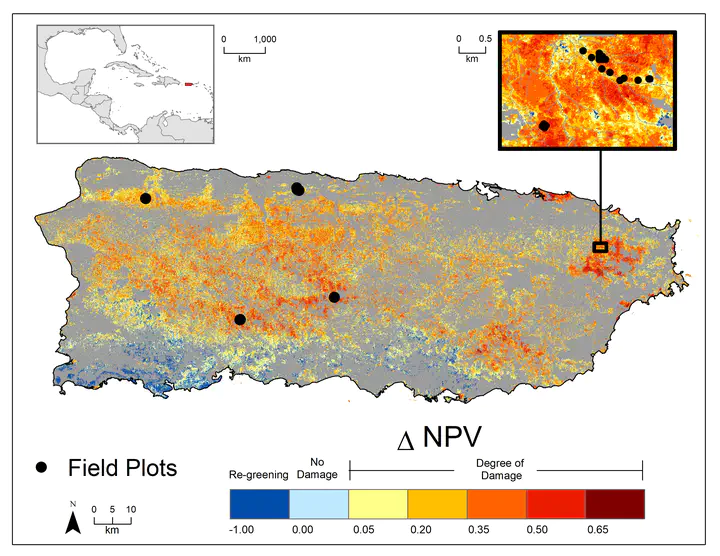Hurricane-induced rainfall is a stronger predictor of tropical forest damage in Puerto Rico than maximum wind speeds
 Fractional change in non-photosynthetic vegetation (ΔNPV) in forested areas of Puerto Rico caused by Hurricanes Irma and María in September 2017. Blue colours indicate absence of damage, including re-greening, while tan to dark red colours indicate damage. A value of 0–0.05 (i.e. light blue) indicates little or no change from the year before the storms (September 15 – November 1, 2016) to after the storms (September 21-November 1, 2017). Black circles indicate locations of field plots measured for this study. The additional inset panel shows the locations of the plots clustered within the boundaries of El Yunque National Forest. Clustered plots include subsections of the Luquillo Forest Dynamics Plot, all subsections of a forest succession plot, all elevation gradient plots, and two climate gradient plots (Supplementary Table S1). Non-forested areas and forested areas not included in the study area due to cloud cover for the study period are shown in grey. ΔNPV was generated from Sentinel-2 TOA imagery28 in Google Earth Engine74 and visualized using ESRI ArcGIS software (version 10.5 https://desktop.arcgis.com/en/arcmap/).
Fractional change in non-photosynthetic vegetation (ΔNPV) in forested areas of Puerto Rico caused by Hurricanes Irma and María in September 2017. Blue colours indicate absence of damage, including re-greening, while tan to dark red colours indicate damage. A value of 0–0.05 (i.e. light blue) indicates little or no change from the year before the storms (September 15 – November 1, 2016) to after the storms (September 21-November 1, 2017). Black circles indicate locations of field plots measured for this study. The additional inset panel shows the locations of the plots clustered within the boundaries of El Yunque National Forest. Clustered plots include subsections of the Luquillo Forest Dynamics Plot, all subsections of a forest succession plot, all elevation gradient plots, and two climate gradient plots (Supplementary Table S1). Non-forested areas and forested areas not included in the study area due to cloud cover for the study period are shown in grey. ΔNPV was generated from Sentinel-2 TOA imagery28 in Google Earth Engine74 and visualized using ESRI ArcGIS software (version 10.5 https://desktop.arcgis.com/en/arcmap/).Abstract
Projected increases in cyclonic storm intensity under a warming climate will have profound effects on forests, potentially changing these ecosystems from carbon sinks to sources. Forecasting storm impacts on these ecosystems requires consideration of risk factors associated with storm meteorology, landscape structure, and forest attributes. Here we evaluate risk factors associated with damage severity caused by Hurricanes María and Irma across Puerto Rican forests. Using field and remote sensing data, total forest aboveground biomass (AGB) lost to the storms was estimated at 10.44 (±2.33) Tg, ca. 23% of island-wide pre-hurricane forest AGB. Storm-related rainfall was a stronger predictor of forest damage than maximum wind speeds. Soil water storage capacity was also an important risk factor, corroborating the influence of rainfall on forest damage. Expected increases of 20% in hurricane-associated rainfall in the North Atlantic highlight the need to consider how such shifts, together with high speed winds, will affect terrestrial ecosystems.
Supplementary notes can be added here, including code, math, and images.